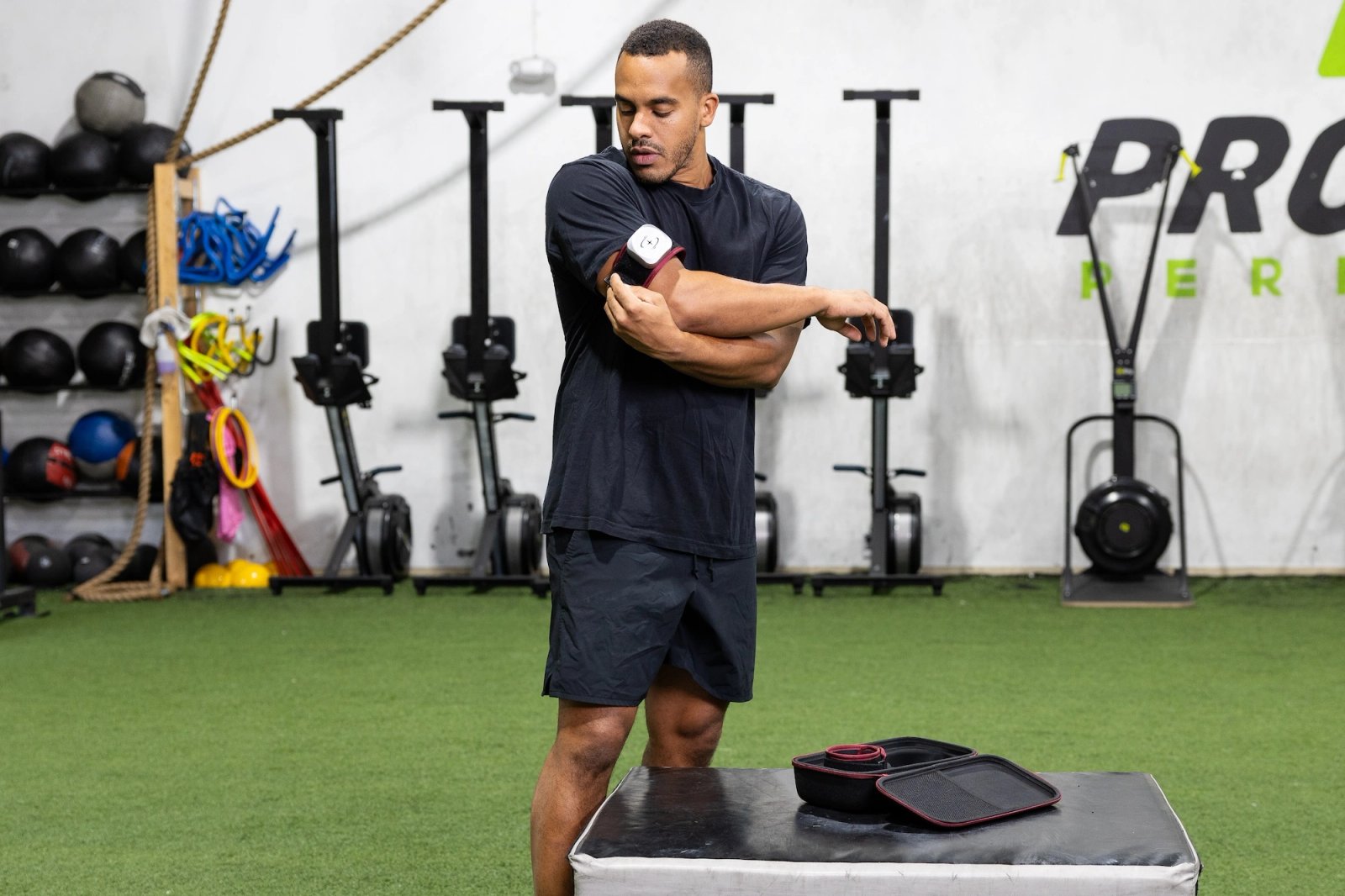Nick Colosi is on a mission to bring the benefits of blood flow restriction (BFR) training to the masses.
A chiropractor turned founder of SmartTools, a Cleveland, Ohio-based company that makes medical, health and fitness equipment, Colosi is betting big on the future of BFR, which has long been used by physical therapists and athletes but could soon make its way into gyms and homes around the world.
BFR training involves the application of bands or cuffs to restrict blood flow to certain areas of the body, usually the upper arm and upper leg, during weightlifting. This allows users to get the muscle and strength-building benefits of training with heavy weights while placing significantly less stress on their joints.
“It kind of tricks the brain into thinking it’s lifting heavier loads than it is,” Colosi tells Athletech News, “At 30% of your one-rep max, you’re mimicking 80% of your one-rep max. That’s what has been shown in the research.”
Thanks to these effects, BFR training has become widely used in physical therapy contexts since it can help people regain their strength while rehabbing from an injury. Athletes also incorporate the technique in-season, when it can be dangerous to lift too heavy.
“LeBron James uses it quite often as a recovery tool after games or practices,” Colosi says.
Bringing BFR to the Masses
To democratize access to BFR training, SmartTools has invested heavily in the modality since around 2017, creating products designed to make it easy for people to get started with blood flow restriction.
The brand’s flagship BFR product, SmartCuffs 4.0, leverages an AI-powered processor and proprietary algorithms to create personalized pressure, known as limb occlusion pressure, or LOP. Users can control blood-flow restriction and other settings from the SmartCuffs app, reducing guesswork and eliminating the need for medical supervision.
“Someone puts the cuff on and the machine does everything for them,” Colosi explains, noting that previously, users had to manually calibrate pressure.
In addition to LeBron, members of the Ohio State football program and the NBA’s Cleveland Cavaliers have used SmartCuffs as part of their training programs. SmartTools also inked a partnership with USA Weightlifting ahead of the 2024 Paris Olympics, giving America’s top lifters access to SmartCuffs during their training.
On the rehab front, both the Mayo Clinic and Cleveland Clinic have outfitted all of their outpatient clinics with SmartCuffs, and SmartTools also has partnerships with some of the largest physical therapy chains in the United States, according to Colosi.
We’re in about 5,000 to 6,000 clinics right now,” he notes.
The next step, Colosi says, is getting SmartCuffs into the hands of the general public.
He sees a future where fitness enthusiasts use BFR training as part of their everyday workout routines to aid in recovery, facilitate deload weeks or increase the recruitment of specific muscle groups.
“At the end of the day, the goal is increased size – muscle hypertrophy – and increased strength,” he says. “That is what BFR does.”
BFR training can be especially beneficial for older populations looking to strength train without exposing their joints to heavy weights.
“I have an 85-year-old customer who uses the product almost every day so he can prevent sarcopenia, which is age-related muscle wasting,” Colosi adds.
How to Add BFR to Your Fitness Regimen
To incorporate BFR into your workout routine, Colosi recommends selecting one muscle group per session and following a simple, high-rep protocol.
“Generally, we recommend 30 reps for set one, then you take a 30-second break. You do 15 reps for set two and take another 30-second break break. Then 15 reps for set three, and take a 30-second break,” he explains.
Less is more when it comes to BFR training, especially for beginners. Colosi says gym-goers shouldn’t do more than 4 sets in one BFR session, since working out with restricted blood flow is challenging.
“It’s not something you’re just going to put on and do a CrossFit workout or something like that,” he says. “You won’t last five minutes.”
While BFR training can be highly beneficial, it’s probably not for the faint of heart.
“It’s not a spa-like treatment, and I tell people that because they’re like, ‘Oh, it’s just like a (Hyperice) Normatec, you’re going to feel good after,’” Colosi says. “If you’re not feeling some discomfort during your exercise, you’re probably not using enough weight or enough pressure.”
As Colosi endeavors to expand access to BFR training, his company has been in discussions with fitness brands including Equinox about potentially adding the products to their facilities.
“We’re trying to get those partnerships with gyms because it’s definitely the next evolution of getting (SmartCuffs) out there to consumers,” he says.
In a world of fitness fads and outlandish marketing claims, Colosi is also quick to point out that BFR training is backed by quality science and research.
“A lot of people just don’t know what it is, and they don’t think it’s safe. It’s very safe; there’s a lot of science behind it,” he says. “Obviously, be cleared by your physician prior to any BFR training, just like you would with any strength training.”
Keep pulse with the latest in fitness news.
Sign Up for Our Newsletter Trusted by 100k+ Fitness, Wellness & Health Executives.
Athletech News provides comprehensive media coverage of the most impactful news and trends shaping the fitness and wellness sector. Our newsletter and website cover emerging fitness technology, brick and mortar gyms, wellness trends, new fitness formats and the industry’s economic outlook.
COPYRIGHT© ATHLETECH MEDIA GROUP LLC 2022, ALL RIGHTS RESERVED
Keep pulse with the latest in fitness news.
Keep pulse with the latest in fitness news.
